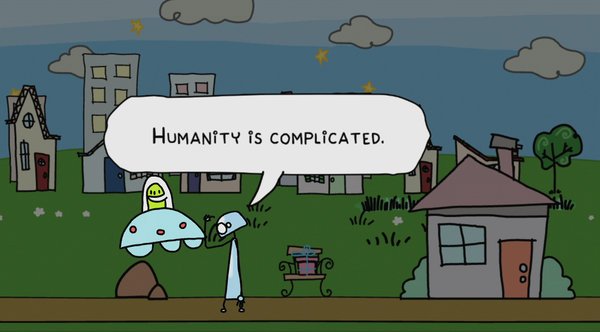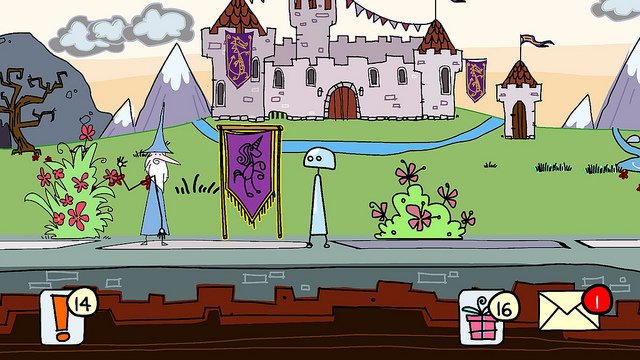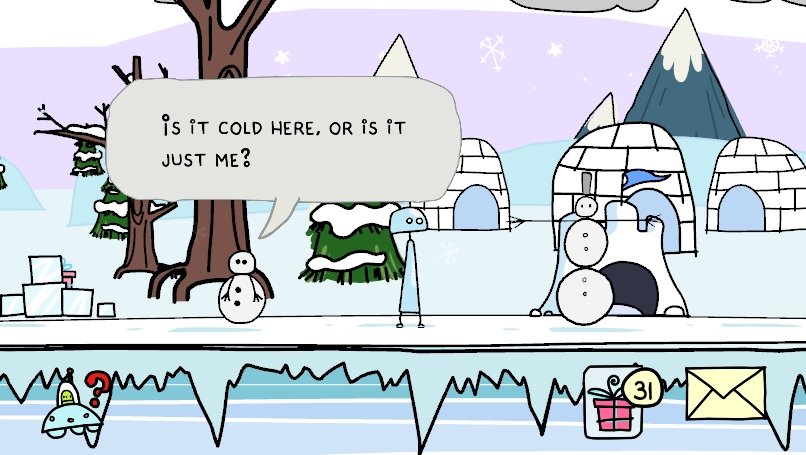It can be a sad realization of the video game industry that when a game has no guns, swords, or violence whatsoever, that it is an anomaly. That’s why when a game like Doki Doki Universe comes out, it can be one of the more original and refreshing kinds of game you can play. Doki Doki relies on character interaction and problem solving as its main crux of gameplay, and while it isn’t the most addictive form of gameplay, it does bring a nice disparity in a time when most games have the same overall objective.
In Doki Doki Universe, you’ll play as QT3, a robot who was abandoned by his human family. QT3 waits dozens of years before an alien, named Alien Jeff, tells him that in order to continue his life and not be turned into scrap, he needs to learn lessons of humanity to become more human. Alien Jeff then takes QT3 to a home planet where he can begin his journey of understanding human nature.
From your home planet, you can travel to dozens of different worlds – which can be done by riding on your “steed,” which starts out as a flying pig – which all help QT3 learn a lesson about humanity. By visiting these worlds, QT3 solves problems that citizens may have that coincide with a certain form of human nature, which then allows him to understand it when he completes all of the missions on that planet.
There are also personality quizzes littered throughout the universe that you’ll take to find out how your QT3’s personality forms. These tell you if you’re anything from a people person, to someone who is open minded, and much more. It’s a nice change of pace from what you’ll mostly be doing in Doki Doki, and I actually looked forward to completing more of the personality quizzes, because the revelations of your choices can be fun to see, and the questions the game asks are fairly entertaining.
Charming doesn’t even begin to describe the world of Doki Doki Universe and the characters that inhabit it. If I were to describe how everything in Doki Doki looks, it’s kind of like taking the doodles out of a notebook from school and dumping them out into a video game; while this may seem like it’s a bad thing – it’s absolutely not. It invokes a feeling of being down to earth, and it drives home the curiosity of QT3. This not only separates the game from looking generic, but helps drive home the atmosphere of innocence the game has.
If you’ve played a game in the Scribblenauts series, you may find solace in Doki Doki Universe. While the games aren’t completely alike, they do share some distinct similarities. The overall movement feels similar, and the basic gameplay in Doki Doki stems from having conversations with NPCs, much like Scribblenauts, that will result in situations or conflicts you’ll need to solve to unlock new objectives and items for future use
Interactions often boil down to finding the right object to give a character in order to unlock further dialogue or interaction with another character. NPCs may also be holding gifts that you can receive by performing certain actions. Some NPCs give you a gift for doing things they like, while others may give you a gift for being mean to them. You can figure out what each character likes by talking to them, as well as talking to other characters. Random presents with “dust bunnies,” the currency you use to summon objects, can be found by moving scenery in the world which may have secret presents hiding behind them.
While the interactions with the inhabitants of all the worlds can be fun, it ultimately becomes tiresome after a while. The game doesn’t introduce many new elements to help the game’s interactions with characters grow, and it stopped the latter levels from being memorable, as the game really dragged on after a while. I found myself having to stop playing for a while so I could pick Doki Doki up later so I could find the game invigorating again.
Doki Doki does have moments on the Vita where the game can’t keep up with all that’s happening on-screen. When you have multiple characters and you decide to move an object or perform an action, the game stutters and the framerate drops rather significantly. Considering the game isn’t that visually demanding, it’s strange that the game wasn’t optimized to run perfectly on the Vita, given the handheld’s power.
Doki Doki Universe isn’t like most games – and that’s a good thing. Its attempt at creating a unique and divergent experience should be applauded, even though it isn’t always successful at doing so. Interacting with the cute and memorable characters is mostly fun, but doing over a dozen worlds of the same song and dance can become rather tiresome, especially with longer play periods. Even with its repetitive nature, those looking for a new experience that is on the more virtuous side will find much to love about Doki Doki Universe.
This review is based on a review copy of PlayStation Vita version of Doki Doki Universe by HumaNature Studios.
- Simplistic, cute art
- Unique gameplay...
- It Can Grow Tiresome
- Stuttering Framerate



